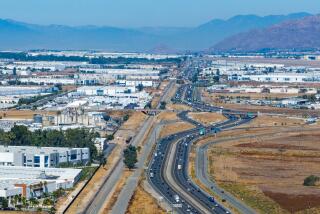Battle Looms Over North City : Environmentalists Cry Foul at Move to Allow Building in Huge Area
- Share via
A veteran of many battles over North County development, Jan Fuchs is gearing up for the next great struggle. At stake is 12,000 acres of barely developed land stretching from Del Mar to Rancho Bernardo.
“This is the No. 1 issue that will come before San Diego for years to come,” said Fuchs, who is involved in several community groups.
This stretch of shrub-covered canyons, mesas and rolling hills has been a battleground in the growth debate before.
In 1985, voters approved Proposition A, the first major growth-restricting initiative to pass in San Diego. A response to City Council-approved plans to build in the area, the controversial initiative wrenched control of the region away from the City Council and halted development by requiring a public vote on all major projects.
Seven years later, the city is moving ahead with plans to put a measure on the 1994 ballot that would invalidate the 1985 initiative.
If the council proceeds with the ballot measure--and it has indicated that it will--and it is approved by voters, it would shift the land out of the future urbanizing zone and allow large projects to be approved by the council without a citywide vote, following guidelines for the area recently approved by the council.
Under the framework plan, several small “villages” will be created in the region, housing about 38,000 people altogether. There would be “clusters” of relatively high-density development around a corridor of open space, with “semi-rural” communities of estates and golf courses.
“The most important thing is to identify open space areas that have value and link them to a comprehensive system,” said Deputy Mayor Ron Roberts, who helped spark the planning effort. “This is the most well-planned open space of any community plan I’ve ever seen.”
While many have hailed the framework as a progressive and insightful compromise, others disagree with Roberts’ assessment. Some activists and environmentalists view it as little more than offering landowners the key to the vault, an opening that will spark the bulldozers into action on the last major stretch of privately held undeveloped land in the city.
In addition, Interstates 5 and 15 would reach peak capacity at rush hours, according to a study of the plan’s impacts.
“This is not a situation where people are mad; people who understand what is going on are outraged,” said former Del Mar City Councilwoman Gay Hugo-Martinez.
Environmentalists and community activists are still reeling from the city’s approval on Oct. 1 of the framework plan, which established guidelines for development in the region.
The plan was developed by a San Francisco-based consultant, Blayne Dyett Greenberg, working with a local committee made up of environmentalists, community activists, land-use experts and landowners. The cost of the planning effort was split between the city and the landowners in the area.
The framework provides that as many as 14,780 units can be built, most of them single-family houses. About half of the land--some of which is in the floodway or too steep to be built on anyway--would remain as open space.
Although the plan had been in development for two years, planning groups and community activists complain that they received a copy of the draft plan only two weeks before the city Planning Commission was due to discuss it. The Planning Commission was still receiving updates and proposed revisions on Sept. 24, when the group voted to recommend it.
Although the council put off voting on the plan from Sept. 21 to Oct. 1, it rejected repeated requests to further delay voting on the plan. The plan was approved, 5-2, with council members Valerie Stallings and John Hartley complaining that the council was acting too hastily. Councilwoman Abbe Wolfsheimer, who represents the future urbanizing area, was in London on behalf of the Metropolitan Transit Development Board. Mayor Maureen O’Connor left the council meeting before the vote was taken.
The council was eager to approve the plan because a year earlier it had publicly promised to lift a moratorium on building in the reserve. The moratorium expired Sept. 21.
Even under Proposition A, development can take place in the area either under current low-density zoning or with the approval of voters citywide. The moratorium was designed to allow for an overall plan to be developed and to coordinate the interests of the various landowners.
“There was no point in belaboring” the vote, said Roberts, since opponents will “have more than one shot” to change specifics of the plan.
“This doesn’t put the bulldozers out there tomorrow. We’re still a couple of years away from a public vote,” Roberts said, noting that it will still be left to city voters to decide whether it is wise to remove the “future urbanizing” restrictions.
But some opponents contend that the plan was “rushed” through the system. There is no need for it, they argue. Activists are vague about their plans, but some have hinted that lawsuits over the framework process or specifics of the plan may already be in the works.
To many of those who have been fighting for growth restrictions for 10 years, the new plan is a sign that a pro-development council majority is trying to turn back the clock to the days when the city was regarded as developer-friendly. That perception among voters led to the 1985 initiative and sparked the city’s slow-growth movement.
“It’s 1985 all over again,” said Planning Commissioner Lynn Benn, the lone vote against the framework plan.
Supporters of the framework argue that development was going to occur in the area with or without the plan. The framework planning process “aggressively” prevented the city from creating another “sea of rooftops,” said Lance Burris, president of Potomac Investment Associates, one of the largest landowners in the area.
Even under the Proposition A guidelines, a landowner can build one unit per four acres if several conditions are met, such as providing open space and affordable housing for low-income families.
Potomac has been developing plans for the past several years to build as many as 2,500 homes, a resort hotel and at least two golf courses on the 4,600 acres it owns in the northeast corner of the region. The first phase of the project--1,217 homes, including 195 low-cost units and two golf courses--meets current zoning requirements and would not require a citywide vote, according to Burris.
Potomac expects to present its development plan for the first phase to the City Council in November. Many environmentalists have already expressed support for the plan, which has homes on half-acre to 1 1/2-acre lots.
Potomac’s second phase would require a city vote, unless voters shift the land out of future urbanizing and remove the requirement for a vote.
The other major landowner in the area, Pardee Construction, has been working under the assumption that its plan to build 5,000 homes on 2,000 acres would require a citywide vote. It has already been lobbying residents in surrounding communities with brochures warning, “Don’t let our neighborhoods be the victims of unplanned growth” and “Help stop the destruction of our neighborhoods.”
“Something is going to happen out there anyway,” said Burris of Potomac. “It is better to plan. Opportunities (to preserve open space) are being foreclosed right now.”
There are more than 140 landowners in the area, which serves to further complicate the process. The vast majority own small parcels of 5, 10 or 20 acres. Many are not developers; they bought their land many years ago when prices were down.
“They’re not speculators,” said Stephen Coury, a public affairs specialist who represents a group of 50 area landowners. “They’re just looking for some sort of predictability or expectation” that they will get some return on their investment “in their lifetime.”
On many of the smaller parcels, only a small percentage of the property is actually developable; others fall into the area designated as open space by the framework plan.
Not surprisingly, many of the smaller landowners were dissatisfied with the plan, which doesn’t allow all of them the densities they would like in order to get a “reasonable” return on their investment.
“If you only own 20 acres and most is encumbered by open space, the city is in effect taking your land without compensating you for it,” Coury said.
The members of his group “reluctantly” supported the framework plan because “the alternative was worse,” Coury said.
The trade-off for the right to build housing at higher densities than the current zoning is the framework’s “environmental tier,” a continuous open space corridor throughout the region. Both activists and landowners have hailed the greenbelt as an unprecedented plan to preserve the environment.
But not everyone is convinced that the current planning effort will truly protect the area’s natural resources. Some argue that, when all is said and done, it will be little more than a narrow strip bisected by roads.
“The environmental tier is being waved as this great green banner, yet there is no guarantee that the open space system will be established,” said Sierra Club spokeswoman Linda Michael, who participated on the citizen’s committee that developed the framework plan.
In particular, Michael scoffs at the idea of golf courses being included as open space.
“It’s nice open space for some wealthy people,” she said.
The San Diego Planning Department now is developing more detailed plans for the area and studying how to pay for municipal services. While builder fees may help pay for schools, roads and other services, opponents point out that the city will still have to pay to extend many services to the area.
Roberts countered that anybody who argues that development won’t pay for services is either “misinformed or lying.”
“If you look at the tax revenues, you’re going to find that this area will not only only pay for itself, it will provide a surplus,” said Roberts, adding that he would not commit the political suicide of supporting a plan that would take services away from his inner-city district.
Supporters of current planning efforts also argue that the plan will guarantee an adequate road system for the area. Many see it as a chance to complete Route 56, the long-planned freeway that would connect I-15 to I-5 south of Del Mar. Conversely, that touches nerves with those who have opposed 56 as unnecessary and damaging to the local environment.
But Burris said the county faces congestion along those corridors with or without the urbanizing plan.
“The freeway system is the freeway system, whether you build here or in Temecula,” Burris said.
Although most of the early planning took into account the potential for mass transit, it might not be financially feasible to extend light rail or the trolley into the area, since the low-density projects would house relatively few people. Some landowners and planners asked the council for higher densities in order to insure that mass transit would make it to the area.
In an effort to minimize the impact on area roads, the planners sought to design self-contained communities that include schools, recreation and shopping.
But Planning Commissioner Benn scoffs at that notion.
“To say that these will be self-contained communities is ludicrous,” Benn said. “These communities won’t be any different than North City West or any other communities developed in the area.”
People on both sides acknowledge that the key will be the ballot measure tentatively planned for 1994.
“If you cut through it all, I think (the process) is positive, because of the vote of the people,” said John Dean, chairman of the Carmel Valley Community Planning Group. “I think it is going to take little effort for people to submarine” the planned 1994 measure.
“I think (developers) have a big job in front of them.”
More to Read
Sign up for Essential California
The most important California stories and recommendations in your inbox every morning.
You may occasionally receive promotional content from the Los Angeles Times.










